
What if a single motif could carry lineage, protection, and a life story at once? We ask this to guide our work as we trace how tribal art shaped early American tattoo flashes and still informs modern design.
We approach each piece with research, respect, and collaboration with culture-bearers. Our visual language uses feathers, arrows, dreamcatchers, animal guides, and celestial elements. Placement matters as much as the motif, since context shapes meaning.
Across time, this art form served ritual, healing, status, and territory. Today a revival within Indigenous communities reconnects technique and story, while artists translate patterns into classic flashes and fine-line realism.
Key Takeaways
- We honor history by researching and consulting with community keepers.
- Symbols like feathers and eagles carry layered meanings tied to placement.
- Design choices balance aesthetics with cultural respect and context.
- Both women and men wore these marks, often with distinct purposes.
- Modern revival blends tradition with contemporary styles and care.
Why We Created This Ultimate Guide to Native American Tattoos
We created this resource so anyone curious about tribal marks can learn the history and meaning first. Our aim is to give clear context so design choices come from informed reasons rather than fast trends.
Historically, these marks recorded achievements, status, rites of passage, and spiritual belief. Many designs used pigments from clay, indigo, and other natural materials. Over time, practices were suppressed and then revived as communities reclaimed techniques.
We wrote the guide to help people make respectful choices. That means we show which motifs are public and which are tied to family or ceremony. Non-people are urged not to copy personal or sacred work.
- We bridge inspiration and education so you get practical ideas.
- We offer placement notes for women and men, and tips to talk with your artist about line, color, and technique.
- We include historical context and modern practice so the next step is respectful and informed.
Deep Roots: The History and Cultural Context of Tattooing in North America
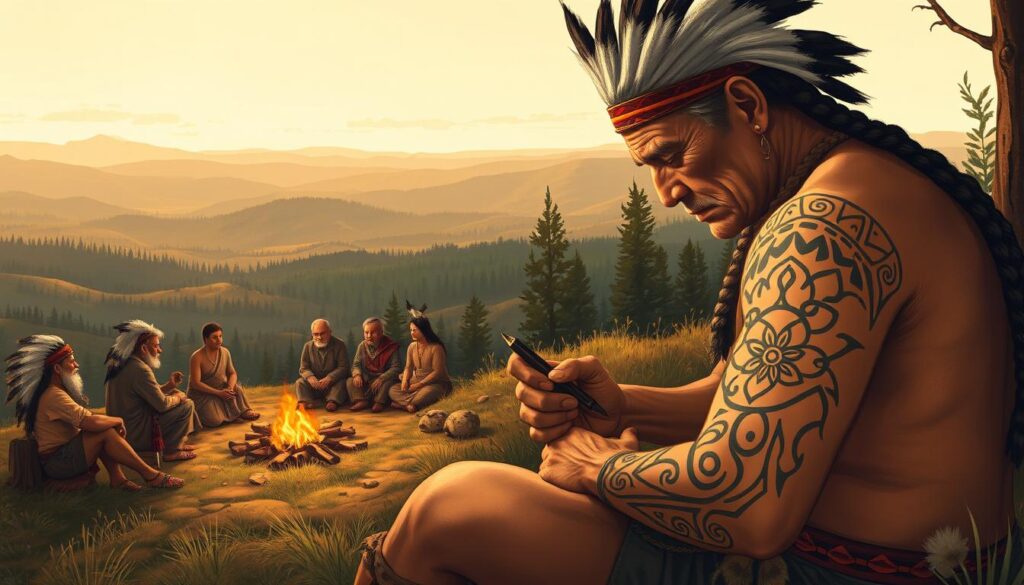
Marked skin carried memory and meaning long before colonial reports mapped the continent.
We trace how tattooing in north america predated European contact by many years. Practices were found across coasts, plains, plateaus, and the Arctic. Early travelers from the 15th century recorded names of communities and described ceremonies and tools.
From war to ritual, marks served many roles. Men sometimes recorded kills or achievements. Women bore chin lines for identity and age in groups such as the Yurok, Tolowa, and Hupa.
Techniques varied: bone points, fish teeth, or sharp needles paired with soot, charcoal, or natural pigments. The process itself held meaning and often formed part of a rite.
Patterns and placements differed by tribe and region. Face, arms, and chest were common because visibility reinforced role and belonging.
Suppression, then cultural revival, reshaped how people practice and show these marks today. We encourage using this history to ask better questions when drawing on older traditions.
| Topic | Region / Groups | Common Placement | Technique |
|---|---|---|---|
| Facial lines | Inuit, Cree | Face, chin | Needles, pricking, soot pigment |
| Chin marks for women | Yurok, Tolowa, Hupa | Chin | Bone points, pigment rubbing |
| Warrior tallies | Plains and coastal tribes | Arms, chest | Sharp teeth, needles, charcoal |
| Ritual & status | Widespread across tribes | Visible areas | Varied traditional tools |
The Ritual and Process: Tattooing as Ceremony, Power, and Protection
Marking the skin often began long before the needle touched flesh, as a ritual of intent and community witness.
Preparation mattered: elders or skilled practitioners led prayer, cleansing, and clear intention. These steps framed the act as a ceremony that bound a person to kin and duty.
Preparation, intention, and rites of passage
We describe rites that marked coming of age, marriage, parenthood, and recovery from trauma. In some groups, chin lines recorded major life events for women.
Medicinal, spiritual, and identification purposes
Marks were believed to grant power and protection—examples include designs placed near the eyes to strengthen sight or courage.
- Protective marks functioned as living amulets tied to placement and prayer.
- Some practices held medicinal value through ritual and community care.
- Motifs often signaled clan ties, roles, or social status within the group.
We stress that intent and process shaped meaning as much as the image. When planning a modern tattoo, set intentions, discuss placement, and honor the ceremony behind the mark.
| Purpose | Example | Community Role |
|---|---|---|
| Rite of passage | Chin lines for major life events | Marks transition to adult responsibilities |
| Protection | “Eagle eye” motifs near eyes | Strengthens vision and bravery |
| Identification | Clan or role symbols | Signals duties and social status |
Reading the Symbols: Meanings Behind Traditional Designs
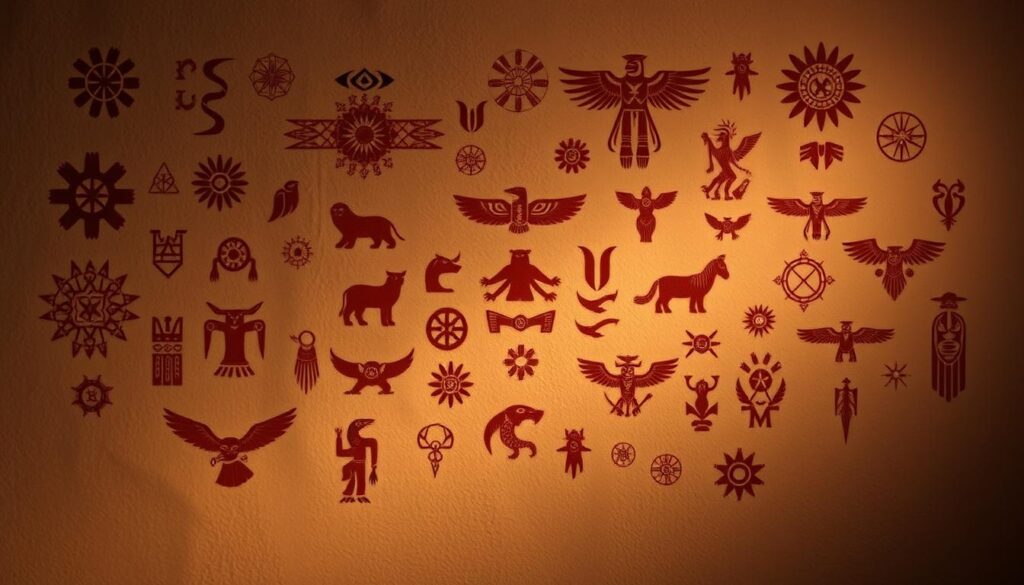
Every animal, line, and star in traditional art signals a role, a history, or a wish. We map core symbols—animal guides, celestial bodies, tools, and abstract patterns—and show how their meanings come from specific tribes.
Common motifs include eagles for creation and freedom, wolves for leadership and protection, bears for strength, and butterflies or dragonflies for transformation. Turtles, buffalo, spiders, and coyotes also carry distinct messages tied to clan and story.
Meaning shifts by place. For example, the same wolf mark can signify family leadership in one community and hunting skill in another. That is why research matters before you choose a design.
Composition matters: line direction, repetition, and spacing read like sentences. Placement on the body changes tone—hands or face announce public roles, while the torso may record private lineage or rites.
- Learn which motifs are personal or sacred.
- Balance clarity and depth so symbols stay legible.
- Document your intent and sources for future viewers.
| Symbol | Common Meaning | Placement Note |
|---|---|---|
| Eagle | Creation, freedom | Chest or shoulder for status |
| Wolf | Leadership, protection | Arm or back for public role |
| Turtle | Health, longevity | Torso or calf for personal meaning |
Quick checklist: align intent, verify local use, consult with culture-bearers, and finalize placement with your artist before getting a tattoo.
Animal Guides and Totems: What Classic Motifs Represent
Many communities read animals as living maps that guide each stage of a person’s journey. Totem animals act as teachers. They mark phases of life and offer rules for how to move through them.
Eagle, wolf, bear
Eagle often stands for vision and freedom—an example is an eagle in flight to signal foresight.
Wolf guides leadership and direction; its forward stance reads as guardianship.
Bear embodies grounded strength and courage, used to convey power and resilience.
Butterfly, dragonfly, snake
Smaller creatures point to change. The butterfly and dragonfly suggest transformation, joy, and speed.
The snake can signal healing and rebirth, a cycle of ending and renewal.
Turtle, buffalo, deer
Turtle signals health and longevity. Buffalo stands for abundance and gratitude.
Deer reads as grace and survival—gentle but cautious.
Spider and coyote
Spider honors creativity and craft; coyote names the trickster, the teacher through challenge.
“Totem animals often guide people through stages of life, shifting as needs change.”
We offer design tips:
- Pair a main guide with secondary marks—tracks, moons, or directionals—to add context.
- Choose scale and placement to fit daily life: discreet marks for women and men who want subtlety; larger pieces for public roles.
- Favor clear linework and texture so animal traits stay legible as the piece ages.
| Animal | Core Meaning | Placement Example |
|---|---|---|
| Eagle | Vision, freedom | Shoulder or upper back for visibility |
| Wolf | Leadership, guardianship | Forearm or chest for assertive display |
| Turtle | Health, longevity | Torso or calf for private significance |
Ethics matter: when a guide ties to a tribe’s sacred story, adapt the theme without copying the sacred narrative. Journal your connection so the mark stays alive in your own life.
For inspired layouts and further examples, see our curated gallery and notes at Aztec designs and examples.
Regional Traditions: Arctic to Pacific Coast to the Desert
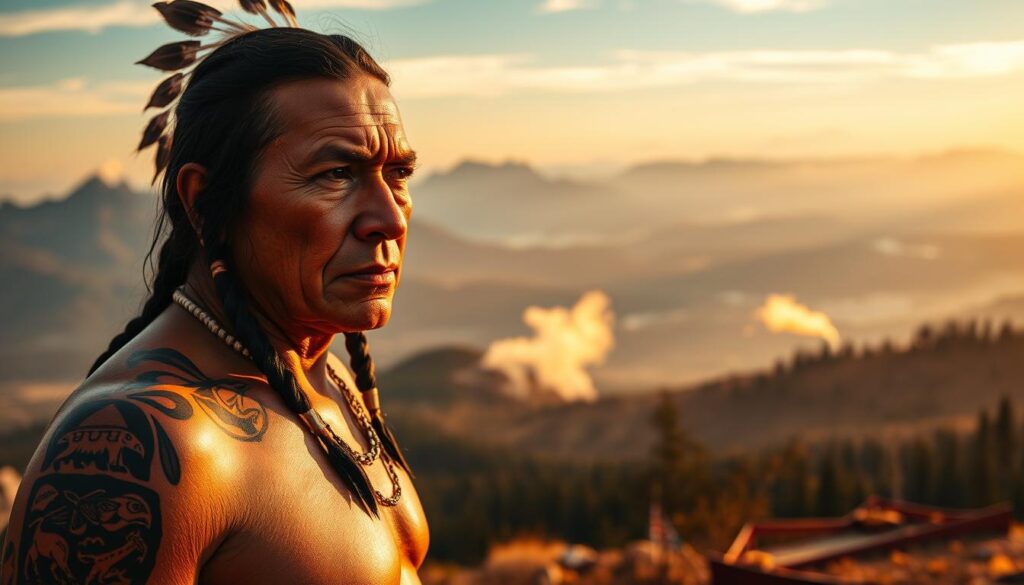
From Arctic chin lines to Mojave facial panels, each area developed its own vocabulary of line, dot, and stripe.
Arctic and Subarctic. Inuit and Inupiat women marked milestones such as marriage, childbirth, and coming of age with chin and cheek lines. Older women often performed the work using thread coated in soot pulled beneath the skin. The result tied beauty, name, and role together.
Plains and Northern Woodlands
Cree practice varied: some men wore extensive body work while women kept simpler facial lines. These marks recorded deeds and status in local social life.
Pacific Coast
Yurok girls began chin stripes around age five and added lines across years. Tolowa and Hupa women commonly wore three vertical chin lines. Hupa arm marks also linked to dentalium shell money and economic standing. Chimariko used stone knives for chin, cheek, arm, or hand marks.
Interior California and Desert Regions
Maidu used obsidian splinters with wild nutmeg charcoal. Miwok favored zigzags and vertical face lines. Tubatulabal worked with cactus spines. Mohave and Yuma believed that facial markings affected passage to the afterlife, so elaborate face designs signaled status and identity.
What this means for us: regional names and local protocols shape meaning. We encourage learning the community history and asking permission before adapting chin or face designs.
| Region | Common Mark | Technique | Social Meaning |
|---|---|---|---|
| Arctic | Chin and cheek lines | Soot-coated thread | Milestones, beauty, naming |
| Plains/Woodlands | Facial lines, body marks | Needles, pricking | Status, deeds |
| Pacific Coast | Chin stripes, arm marks | Stone knives, needles | Age, economy, identity |
| Interior/Desert | Facial panels, zigzags | Obsidian, cactus spines | Afterlife belief, social rank |
Techniques, Tools, and Color: From Bone Needles to Natural Pigments
Hand methods and local pigments gave each community a distinct visual language.
We unpack traditional toolkits and explain how choices shaped line quality and healing. Cactus spines, bird and animal bones, fish teeth, and obsidian splinters were common cutting tools. Some groups also used sinew thread coated in soot to pull pigment beneath the skin.
Cactus spines, bird bones, sinew thread, and soot
Thread-and-soot methods created continuous lines with smooth saturation. Pricking or cutting with spines or flint produced dotted or incised textures and different scar patterns.
Clay, indigo, and wild nutmeg charcoal for hue
Pigments came from soot, clay, indigo, and wild nutmeg charcoal. Hue choice helped visibility on the body and carried symbolic meaning.
- Technique affected healing time and scar texture; cuts often healed with more raised scars than punctures.
- We compare hand methods to modern machines and suggest ways to emulate hand-tap aesthetics without misrepresenting tradition.
- Test small line studies and micro motifs before larger work, especially near the face.
“Materials around a community became the palette for its body art.”
| Tool | Region | Pigment | Typical Effect |
|---|---|---|---|
| Cactus spines | Interior/desert | Wild nutmeg charcoal | Fine incised lines, light scarring |
| Bird & animal bones | Coastal and plateau | Clay or soot | Controlled cuts, durable marks |
| Sinew thread (soot-coated) | Arctic / Subarctic | Soot | Continuous dark strokes, smooth fade |
| Obsidian / flint | Interior California | Indigo, charcoal | Sharp, graphic incisions |
We note that both women and men participated in these practices over years, with tool choice matched to placement and purpose. For background on the broader history of tattooing, see when tattooing began at this brief history.
Social Status, Age, and Life Milestones in Native American Tattooing
Many groups read skin marks as living records that tracked age, rank, and social claims.
Marks tied a person to family, duty, and a public role. In some Inupiat communities, chin lines marked marriage, childbirth, and recovery from trauma. Other groups placed bold marks between the shoulder blades or across the chest for warriors.
Coming of age, marriage, motherhood, and warrior marks
We explore how marks for coming of age, marriage, and parenthood affirmed belonging and responsibility within the tribe.
Placement encoded meaning: chin lines often signaled life stages, while back or chest marks announced warrior status. These signs functioned as public records of lineage, territorial rights, and earned rank.
- Age influenced timing—some marks waited until achievements were publicly recognized.
- Both women and men bore meaningful signs; roles shaped placement more than hierarchy.
- Warrior marks served as deterrents and declarations, designed for visibility and impact.
We encourage honoring the spirit—marking important moments—without copying sacred or restricted patterns. For a modern milestone tattoo, choose a personal symbol, clear placement, and consult cultural stewards when appropriate.
“The body served as an archive of commitments, transitions, and relationships.”
Women and Men: Different Purposes, Different Placements
Where a mark sat on the body told a story as clearly as its lines. Placement signaled beauty, role, and rank. We look at common zones and how they read in life and ceremony.
Chin, forearms, shoulders, and calves for women
Women often wore marks above the breasts, on shoulders, along forearms to the knuckles, and on the calves. Chin lines were common in several coastal and Arctic traditions and acted as clear milestones.
These placements balanced visibility and daily life. Shoulder and forearm marks announced identity and skill. Calf and chest marks linked to beauty and private rites.
Chest, thighs, below the knees, and warrior back marks for men
Men’s work frequently covered the chest, thighs, and legs below the knees. Marks between the shoulder blades served as warrior identifiers and were meant to intimidate in confrontation.
Placement followed movement. Chest and thigh panels read from a distance; lower leg marks fit mobility and armor. Back marks were public statements of status in conflict.
- Face and chin placements carried strong messages and need deep cultural context.
- Different zones age and fade in distinct ways; artists plan lines for longevity.
- Modern strategies can nod to tradition while avoiding protected or personal designs.
- Consider work, clothing, and activity so a piece fits daily life for years.
“Placement is part of the story—choose a site that honors meaning and fits your life.”
| Gender | Common Zones | Primary Meaning |
|---|---|---|
| Women | Chin, shoulders, forearms, calves | Beauty, milestones, identity |
| Men | Chest, thighs, below knees, back | Warrior role, status, visibility |
| Contemporary | Inner arm, rib, calf, upper back | Respectful nods to tradition; private placement |
Placement Matters: Aesthetic Choices and Cultural Significance
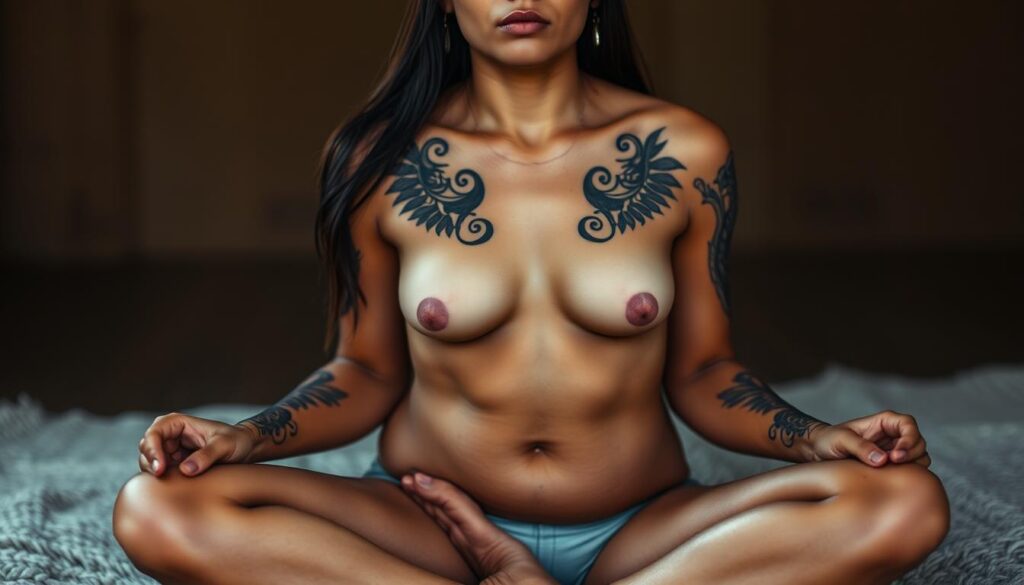
Choosing where to place a design shapes its voice, from private memory to public statement.
Arms, sleeves, forearms, calves, and thighs are popular today because they flow with motion and show well in daily life.
We help you weigh visibility, symmetry, and movement when choosing these zones. Long muscles suit repeating motifs like feathers or tracks. Curves guide line flow so the image reads when you move.
Practical ways to plan
- Adapt scale for women and men so the piece fits limb length and circumference.
- Use negative space, line-width shifts, and paneling to keep large work cohesive.
- Avoid face and chin placements unless the design and permission are culturally appropriate.
- Test layouts with temporary stencils to see how the piece breathes during activity.
- Account for skin texture, sun exposure, and friction to plan touch-up timing and longevity.
Long-term idea: start with a focal motif, add supporting elements across sessions, and choose placements that fit your work and life today and the way you expect them to change.
Native American Tattoos
Modern studios often reinterpret tribal motifs, balancing visual flair with cultural responsibility.
We frame this section as a hub for how traditional themes reach today’s shops. Popular motif families include portraits with headdresses, eagles and ravens, wolves and bears, dreamcatchers, feathers, moons, suns, and arrows.
Respectful approaches: seek explicit permission before using a living nation’s name, seal, or flag. For scripts (Cherokee, Cree, Blackfoot), verify spelling with community sources.
- Compare composition: fine-line, blackwork, and realism each change tone and clarity.
- Adapt placement for women and men so motifs fit anatomy and intent without copying sacred layouts.
- Start small—test a single symbol before building a larger, multi-element piece.
We recommend documenting your research trail. Note sources, artist conversations, and permissions so the design’s meaning is clear to future viewers.
“Work with artists who can explain how they will honor the story while delivering technically sound, long-lasting art.”
| Motif family | Studio approach | Permission note |
|---|---|---|
| Portraits & headdresses | Realism or illustrative shading | Avoid sacred regalia without community approval |
| Animal guides | Blackwork, fine-line, or stylized totems | Clarify clan-specific meanings before use |
| Scripts & seals | Small, precise lettering | Verify spelling and ask for consent |
Design Ideas We Love: Portraits, Feathers, Arrows, Dreamcatchers, and More
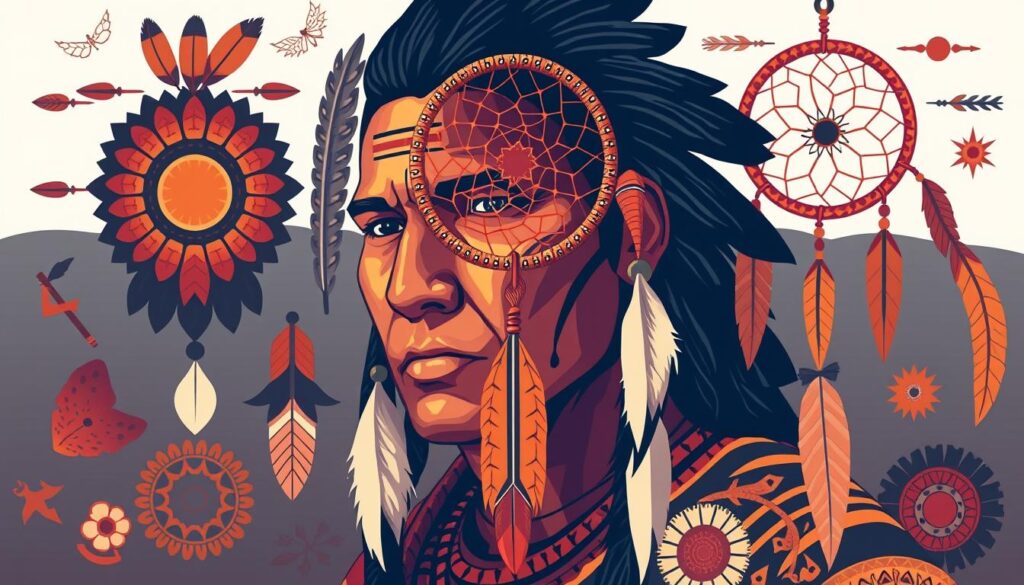
We collect design directions that balance historic signals with wearable, modern layouts. Our goal is to offer creative ideas that respect origin and fit everyday life.
American tattoo designs inspired by traditional art
Portraits: consider symbolic portraits rather than direct likenesses. Use stylized profiles, regalia elements, or framed badges to honor figures without copying sacred imagery.
Feathers & arrows: clean-line feathers and flowing arrows read well on forearms and calves. They move with the body and scale nicely for both men and women.
Totems, thunderbird, moons, and natural elements
Animals and totems work as silhouettes, tracks, or negative-space marks. Pair a main guide—thunderbird, wolf, bear—with low-contrast textures to keep clarity.
- Color palettes: clay, indigo, and warm earth tones translated into modern, safe inks.
- Modular layouts: primary symbol plus moons, plants, or beadwork borders for future additions.
- Dreamcatcher caution: avoid cliché forms; favor fresh, protective motifs instead.
“Choose compositions that speak to your story while leaving room for growth.”
| Design | Placement | Notes |
|---|---|---|
| Portrait-inspired badge | Upper arm, chest | Symbolic features, no sacred regalia |
| Feather & arrow flow | Forearm, calf | Long lines suit motion; good for men and women |
| Animal silhouette + tracks | Outer upper arm, shoulder blade | Subtle symbolism; modular expansion |
Consult checklist: bring references, test sizes, pick color options, agree healing timelines, and confirm aftercare before you book the session.
Modern Times: Revival, Artists, and How Traditions Evolve
Recent decades have seen a careful revival as communities reclaim lost techniques and meanings. We watch an art form return through community-led projects, apprenticeships, and studio practice. This renewal shows how history and present life reconnect.
Renaissance and the tattooing community today
After years of suppression, elders and new makers rebuilt skills and stories. Community ceremonies and teaching circles restored linework and pigment knowledge.
- We chart a revival driven by tribal-led programs that restore technique and meaning.
- Many artists balance innovation with continuity, using modern hygiene while honoring teachings.
- Facial and chin marks have returned carefully within communities and are not generic style choices.
- Practitioners curate references and consult culture-bearers to set an ethical bar for collaboration.
- This renaissance touches lives—restoring pride, reuniting families, and rebuilding ties across years.
How we recommend people engage: support Indigenous artists and projects, ask how designs relate to specific groups, and favor personal stories over copying sacred elements.
“A living tradition adapts without losing its source—respectful collaboration keeps meaning intact.”
| Focus | Why it matters | Action |
|---|---|---|
| Community-led revival | Restores technique and memory | Learn from local programs |
| Artist collaboration | Balances safety and tradition | Ask about training and sources |
| Respectful boundaries | Protects sacred marks | Use universal themes and personal intent |
Working With Artists: Getting a Respectful, Custom Native-Inspired Design
A thoughtful brief turns visual inspiration into a design that honors people and place. We begin with research, then move into clear collaboration so the final piece fits your life and intent.
Researching tribe-specific symbols and lineage
Start by verifying scripts, seals, and names with reliable sources. Tribe-specific scripts (Cherokee, Cree, Blackfoot) carry precise spelling and history.
Ask permission when a motif might be personal or sacred. If you cannot confirm, avoid copying it.
Collaborating on bespoke artwork and placement
Give your artist a clear brief: your story, themes, and limits. We suggest a consult flow: moodboard, motif shortlist, placement tests, and 2–3 iteration rounds.
- Adapt themes like protection or transformation without lifting ceremonial patterns.
- Choose placement that fits daily life for men and women and respects sensitive zones.
- Document sources, permissions, and design choices in your project file.
“A custom piece should be as much about intention and process as it is about the final image.”
When possible, review guidance with community members. Working this way keeps respect and craft at the center of the design and the needle.
Cultural Respect and Considerations for Non-Native People
Respectful use of cultural imagery starts with learning who holds the stories and why they matter.
We define appreciation as learning, asking, and crediting sources. Appropriation copies private or sacred signs without context or consent.
Why not to copy personal or sacred designs
Many sources advise against copying designs tied to ceremony or lineage. Face and chin marks, in particular, carry deep significance and are often reserved for community members.
There are clear reasons to avoid lifting such work: it misrepresents identity, erases protocol, and can harm living people and tribes.
- Follow protocols: research tribe-specific rules and ask permission when possible.
- Choose themes—protection, gratitude, transformation—and create original art that honors context.
- Be transparent: note inspiration in captions and conversations; do not claim affiliation you don’t hold.
- Support with action: commission Indigenous artists or donate to cultural programs.
| Concern | What to do | Why it matters |
|---|---|---|
| Sacred marks | Avoid copying | Protects ritual meaning |
| Face designs | Reserve for community members | Signifies role for women and men |
| Shared motifs | Reinterpret abstract lines | Honors form without lifting clan-specific patterns |
“We encourage ongoing learning: research, permissions, originality, accurate language, and continued support.”
From Inspiration to Ink: Curated Ideas to Start Your Design Journey
We map a clear path from inspiration to the needle so your idea becomes a thoughtful, wearable piece. Choose a theme—transformation, protection, or lineage—then pick a lead symbol and supporting marks that form a coherent story.
Palette tests matter. Try earth reds, indigo blues, and dense blacks in small swatches. These echo traditional color sources while using modern inks that heal well.
We outline templates that adapt for men and women: forearm flows, outer arm panels, calf wraps, and thigh fields. Build a reference deck that shows line weight, texture, and spacing you love, not just finished examples.
- Translate inspiration into an original native american tattoo brief your artist can refine.
- Scale guides keep detail readable from conversational distance.
- Plan multiple sessions to stitch a unified story and reserve space for milestones.
- Pick respectful alt-motifs when an element is culturally sensitive.
- Test color and grayscale mockups against your skin tone and daily wear.
“A clear brief and small tests protect meaning while letting design grow.”
| Step | Purpose | Who it fits | Action |
|---|---|---|---|
| Theme & lead symbol | Anchor the design | Anyone starting a project | Choose theme; select primary motif |
| Palette & mockups | Confirm color and contrast | Men and women | Test swatches, grayscale images |
| Reference deck | Guide artist decisions | Custom work seekers | Collect line weights, textures, spacing |
| Pre-session checklist | Ensure smooth session | All clients | Hydrate, rest, ask technique/healing questions |
Conclusion
For generations, people used durable marks to name achievements, claim belonging, and ask for strength. This guide shows how tattooing across north america recorded ceremony, identity, protection, and life milestones.
Time tested regional methods—from chin and facial marks to chest and arm panels—and shaped a living art. We urge research, respectful collaboration, and original designs that honor source communities without copying sacred patterns.
Choose themes thoughtfully, match placement to your way of life, and work with artists who explain intent and technique. Women and men should pick sites that fit long-term needs and visibility. Bring questions to a consult; we’ll help translate meaning into a balanced tattoo you can wear with pride.
